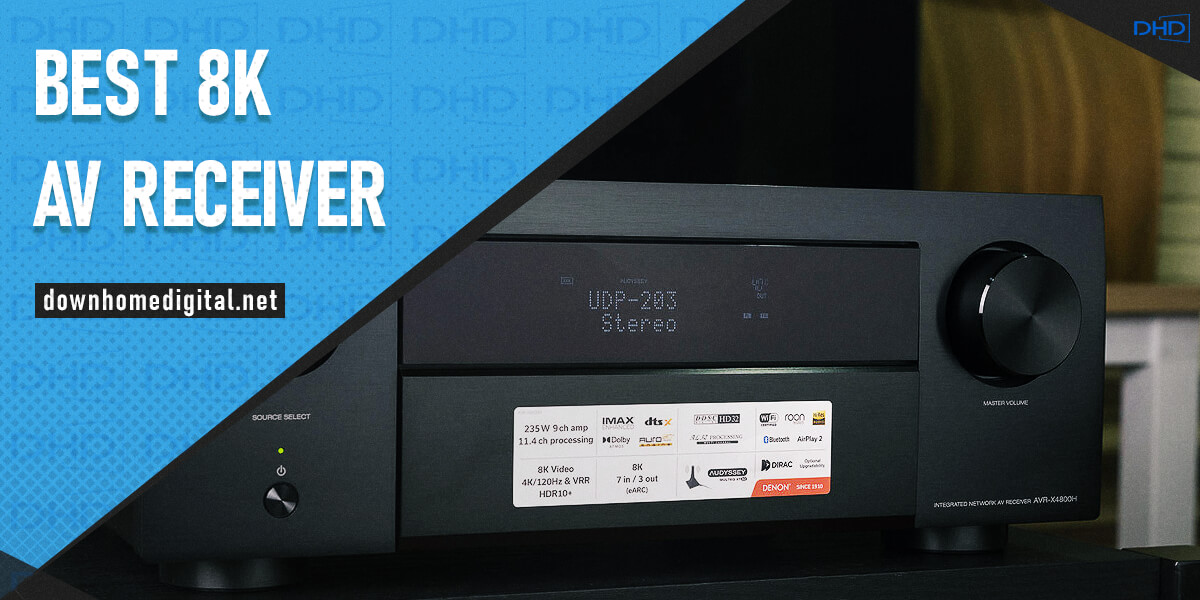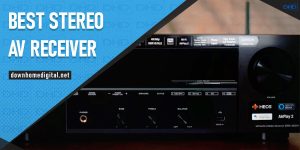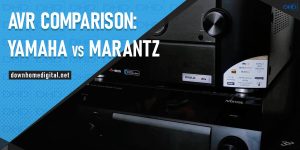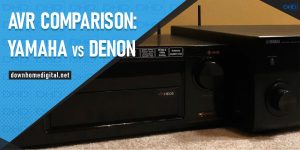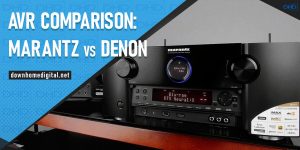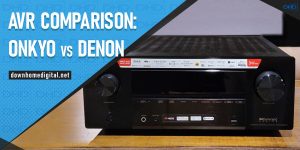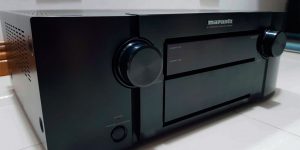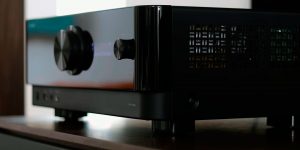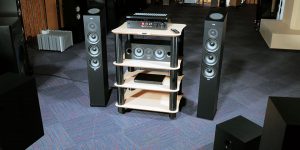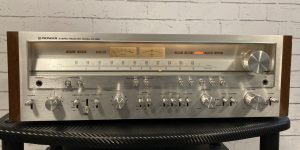8K technology is rapidly gaining popularity in the market, and the demand for receivers that support it is increasing. This innovation offers a more vivid and life-like viewing experience with a resolution four times greater than 4K and sixteen times greater than Full HD. Best 8K receivers can provide their owners with incredible video content quality and a breathtaking movie-watching experience. But how do you pick a truly worthwhile model?
In this review, I have selected the most interesting top 8K receivers available on the market. These home theater receivers offer a seamless integration of 8K technology, allowing you to enjoy an incredibly sharp and detailed picture quality. Furthermore, most of them are equipped with the latest technologies, which, apart from the highest image quality, also guarantee advanced sound processing and the most comfortable use.
Even if the receiver has 8K capabilities, that does not necessarily make it the most optimal for you. First, you must determine how simple it is to use and what additional features are available before making a choice. You may discover all of this from my reviews and the findings of the in-depth testing I conducted on each model I chose. In the meantime, let’s briefly discuss whether you need such a receiver.

8K receiver comparison table
| Name | Channels | Power output | HDMI in/out | Bluetooth/Wi-Fi | Review |
|---|---|---|---|---|---|
| Denon AVR-X4800H best overall | 9.4 | 125W/8 Ohm, 165W/6 Ohm | 8/3 | yes/yes | Review |
| Marantz SR8015 premium | 11.2 | 140W/8 Ohm, 175W/6 Ohm | 8/3 | yes/yes | Review |
| Denon AVR-S670H budget | 5.2 | 75W/8 Ohm, 100W/6 Ohm | 6/1 | yes/yes | Review |
| Denon AVR-S970H under $1000 | 7.2 | 90W/8 Ohm, 125W/6 Ohm | 6/2 | yes/yes | Review |
Do I need an 8K receiver?
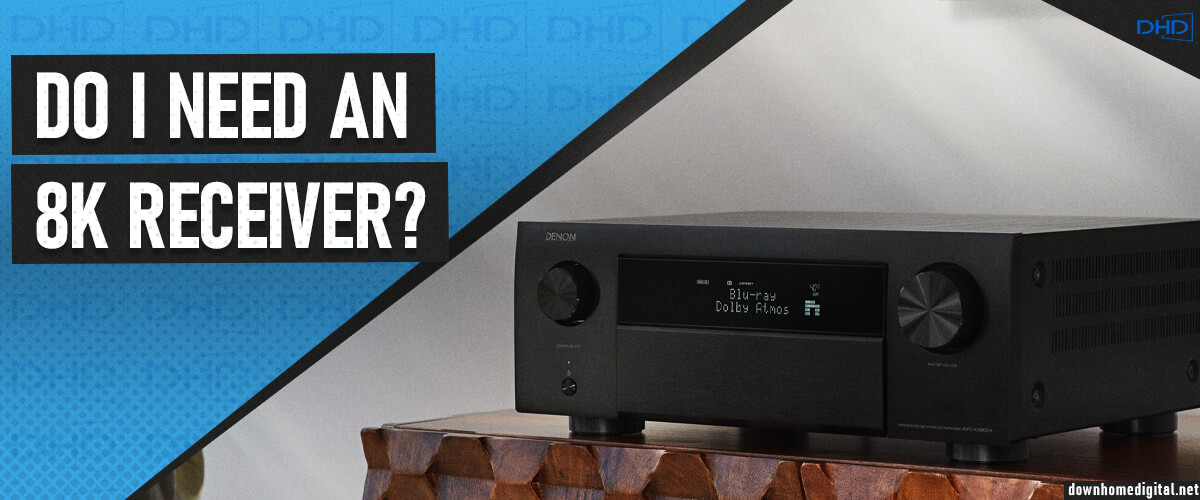
With the advent of new technology, whether to upgrade to the latest gadgets is always a hot topic. It holds true for televisions and their accompanying components, such as AV receivers. The 8K format is no exception. But, with the movie industry still in the early stages of adopting 8K. So, there is still too little available 8K content, which raises the question: do I need an 8K receiver?
Although the 8K technology is still developing, there are several advantages to switching to a receiver that supports it. Firstly, the shift to HDMI 2.1. This technology enables 8K/60Hz streaming and delivers 4K streaming at up to 120 frames per second instead of the typical 60. It can result in a more fluid motion on the screen. Depending on your preferences, this could make the upgrade worth it. The aforementioned is especially true for gamers, as this frame rate is mostly desired and achievable in video games.
In addition, such receivers, in addition to supporting 8K, are usually equipped with other modern and valuable features. These can include Automatic Low Latency Mode (ALLM) for reduced input lag, Variable Refresh Rate (VRR) that eliminates screen tearing and stuttering, Quick Media Switching for faster transitions between media types, and support for the latest audio and video formats. 8K units are top-of-the-line products of their brands, so companies do their utmost to fill their units with cutting-edge technologies.
Despite the cost of such units and a clear lack of 8K content, the benefits of upgrading to an 8K receiver are worth considering. With its incredible image quality and cutting-edge technologies, it may be a wise investment for those who value the latest technology and the brightest viewing experience.
Best 8K receiver reviews
Denon AVR-X4800H – best overall
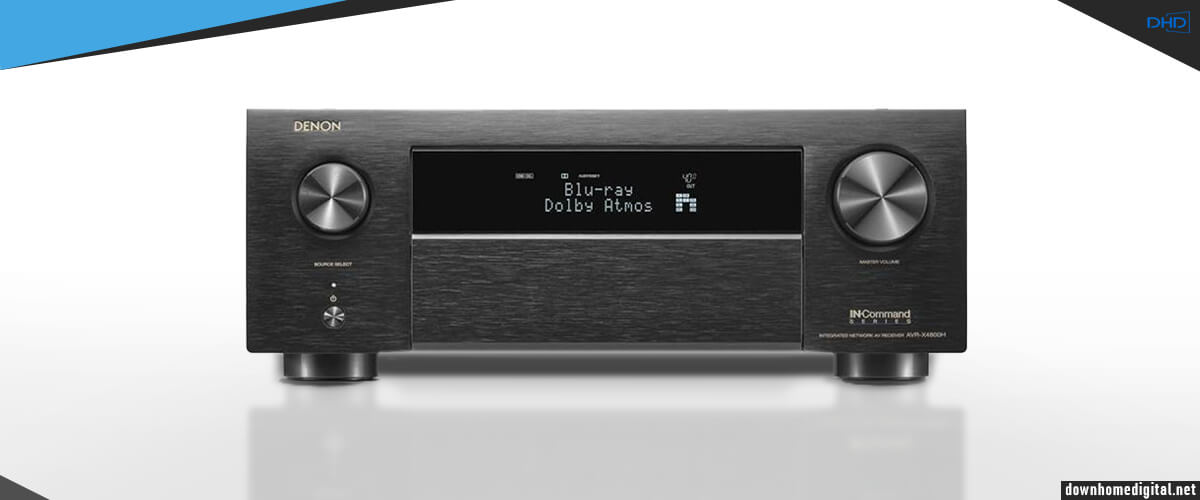
The Denon AVR-X4800H is a premium model with 9.4 channels of amplification that can expand your system to 11 channels with an external amplifier. As you may have noticed, you can connect 4 independent subs, something that few receivers offer. Given the not-so-high power (for 11 channels) of 125 watts (8 ohms, 20 Hz – 20 kHz, 0.05%, 2ch), this can be an important addition if you dream of your floor shaking from explosions on the screen. Only the more expensive Marantz SR8015, which takes second place in the review, can do this. Considering such capabilities and applying the main criterion – price/quality ratio – AVR-X4800H confidently gets the “gold” of my rating.
From my perspective, the design of the Denon AVR-X4800H is well-thought-out and user-friendly. The receiver has a standard traditional appearance. It has a clear, easy-to-read display that shows all the necessary information, including input sources, volume, and status indicators. Traditionally all the control surfaces are located on the front panel. In general, it’s nothing unique, and it’s quite usual for a high-end receiver, but still, I like the look and the convenience of the panel hidden under the cover the most against the background of other brands. It is uncomplicated but reliable and requires minimal maintenance. Many complain about the lack of an HDMI port on the front, but I need it only if AVR has few connections on the back panel (usually, you connect a home theater and don’t touch it for a long time). So, I don’t consider it a disadvantage as the model has more than enough connections.
The Denon AVR-X4800H has every necessary port, including 7 HDMI inputs with 3 outputs, 3 composite videos, 5 analog audio, 2 digital optical and coaxial inputs, and a single output. Sadly, you can’t use the front USB without affecting the looks of the receiver, as one has to open the decorative cover on the front panel.
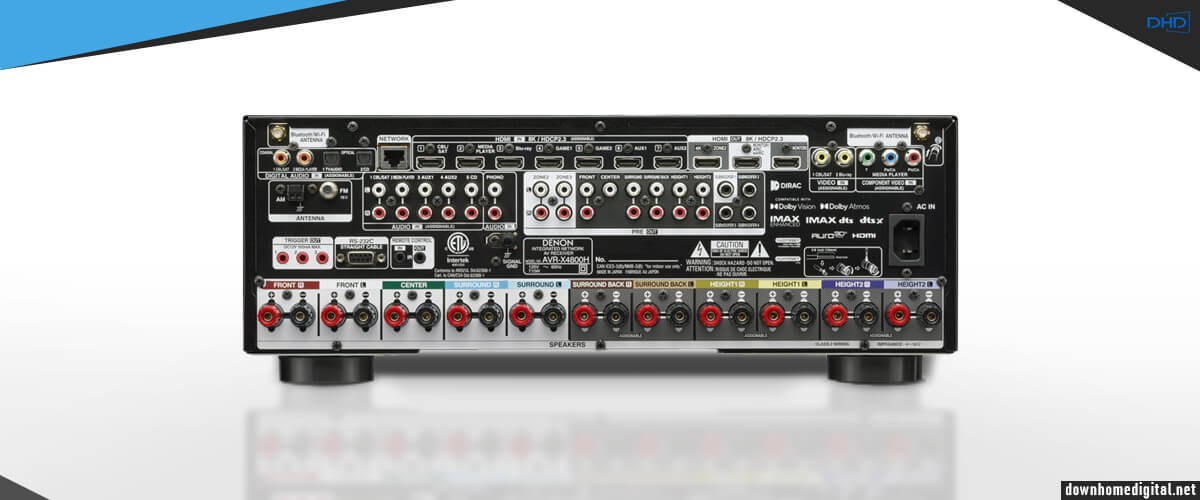
It can deliver high-quality video content with its support for 8K resolution and HDR10, HLG, and Dolby Vision HDR formats. In addition, the HDMI 2.1 technology allows for seamless 8K/60Hz and 4K/120Hz video pass-through. This is not the only receiver in my review with all HDMI supporting 8K; there is also a 7-channel Yamaha RX-A4A. But this is the optimal figure compared to the number (7) and considering the premium category. Marantz SR8015 has only 1 such port.
Of the outstanding features, the Denon AVR-X4800H stands out with its 8K upscaling and HDMI 2.1. As you may have guessed, this surround sound receiver supports modern sound processing formats, including Dolby Atmos, DTS:X, and Auro-3D. The receiver also offers multiroom capabilities with its Zone 2 feature. It has a number of additional features, including built-in Wi-Fi, Bluetooth, and AirPlay 2 for wireless connectivity, as well as support for Alexa voice control and Google Assistant.
After using the Denon AVR-X4800H for several weeks, I was impressed by its overall performance. The 8K support and capable upscaling provide a seamless and immersive viewing experience, while the advanced audio processing system delivers clear and powerful audio with my speaker’s setup. For me, the upscaling is one of the most pleasing parameters of the unit, as 8K content is still pretty rare. I often had to use this feature to turn my 4K content into an 8K one.
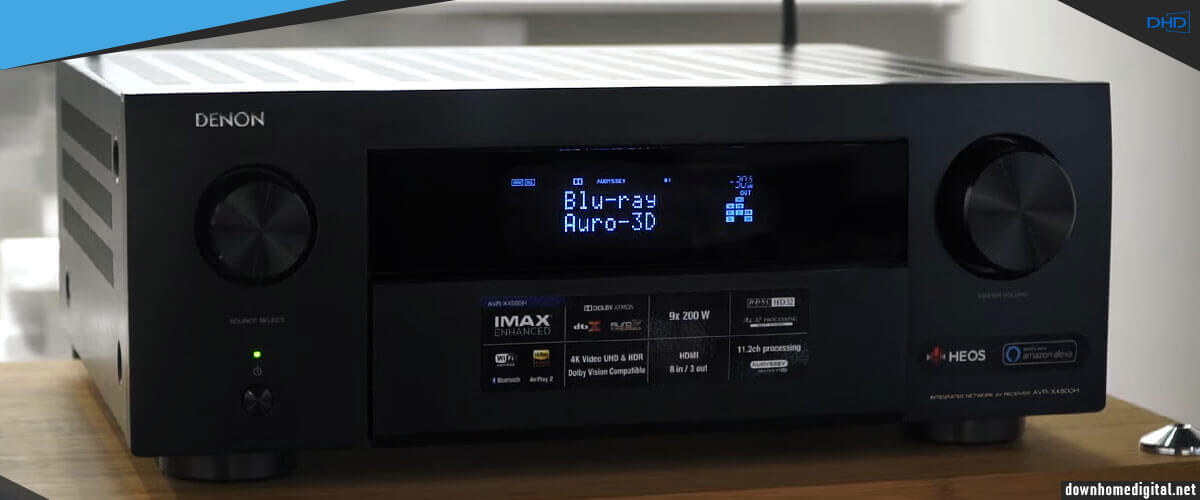
First, I tested it with movies. The receiver did not disappoint me and produced an accurate, detailed, and vivid sound. It faithfully reproduces every detail, even in the most difficult moments. Of course, it may surprise you that the reviews most often mention Marvel movies (as if the testers have the same taste or just write each other off). But it seems to me that the franchise’s popularity and the sound effects used in any of the series can explain the receiver’s capabilities to the reader. The AVR-X4800H performed incredibly well in Dolby Atmos in Thor: Ragnarok (one of my favorites because of Led Zeppelin and Cate Blanchett), and I heard every element intended by the writers, especially in scenes where there was a lot of sound layering (the battle on the Bifrost Bridge). As I said, adding the 4 subs does its job, but if you remove them, the AVR’s power drops significantly, inferior to the Marantz SR8015’s capabilities.
The AVR-X4800H has also proven to be quite capable in music. I generally believe that if you are looking for a versatile home system center, you should consider Denon (or Marantz). It’s great for instrumental music and does a great job with vinyl as its sound is warm, the closest thing to realistic.
Speaking of stereo, I incredibly liked the tandem of the receiver in question and the Klipsch RP-6000F front speakers. I generally find them optimal for many users, including the price/performance ratio. But with Denon hybrid Tractrix horns sound somehow especially natural, revealing the potential of the receiver itself and compositions, as if extracting long stale notes.
The Denon AVR-X4800H is the best 8K receiver for upgrading your home theater system or for getting acquainted with the latest in-home theater technology for the first time. It is easy to set up, even for an inexperienced user. Considering the average cost, the possibility of expanding the system up to 11 channels, and the possibility of increasing the power through 4 independent subs and modern features (8K on all HDMI ports, wireless technology, wide connectivity options), you will have enough of it for many, many years.
Its versatility can only be shouted about. I’d like to mention the flawless operation of HEOS multi-room, excellent 8K upscaling, and gamer features. All of this will suit a large family with a variety of tastes. You’ll be able to watch movies or listen to music with the same high quality. The AVR-X4800H is worth every penny invested in it.
| Power |
|
| HDMI features |
|
| Video features |
|
| Network |
|
| Surround sound processing |
|
Pros
- The optimal price/performance ratio in the premium segment.
- With this 9-channel receiver, you can create an 11.4 system.
- You can connect 4 independent subwoofers, making the sound more powerful and physically tangible.
- All HDMI ports support 8K video, which surpasses the capabilities of the rest of the selection.
- The 8K upscaling showed excellent results.
- User-friendly interface, easy to set up for beginners.
- Flawless operation of HEOS multi-room.
Cons
- Low frequencies are significantly inferior to Marantz SR8015 unless you connect subwoofers.
Marantz SR8015 – premium
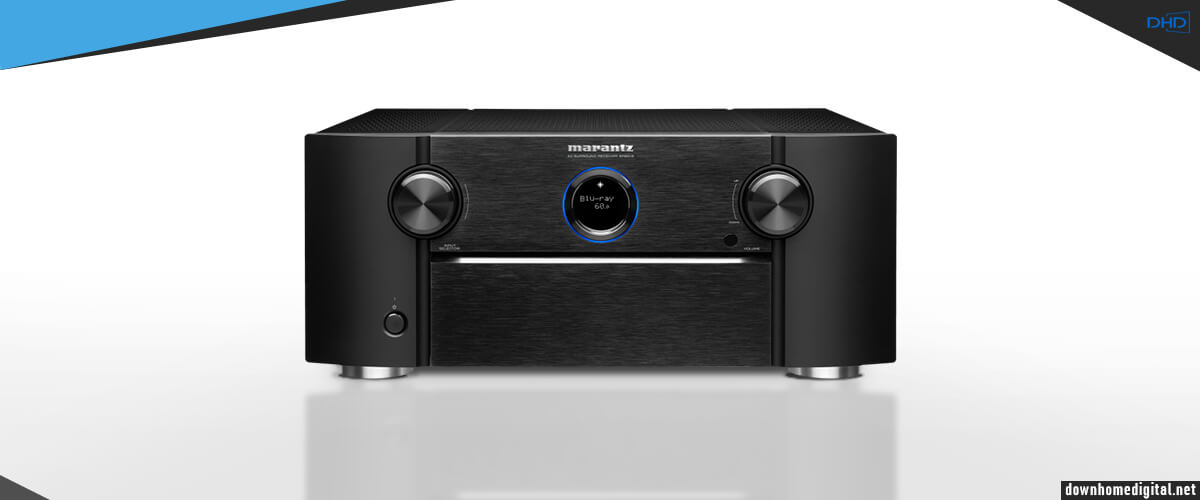
Marantz SR8015 is the main competitor of the leader of the selection Denon AVR-X4800H, but it takes only second place. Although, to be fair, it should be said that the competition practically ends here because further on, there are more simple receivers with 7 and 5 channels of amplification. But that’s not the point. In the case of Denon and Marantz, the competition is highly debatable. The brands have not so long ago merged into an alliance but have retained their individuality, where the second occupies not just a premium but an elite niche. So get your wallets ready; the SR8015, even with the reduced price, is worth a lot today.
The receiver features a sleek and stylish design with a brushed aluminum finish and an intuitive user interface. I also enjoyed its easy-to-navigate menu and decent-sided control surfaces supplemented by the convenient remote. I also often mention the ridiculous round little LCD you can’t see anything on, which drives me up the wall. However, many users find it beautiful (objectively, I agree; you can recognize a Marantz from afar by it). But the expensive models have a normal screen under the cover. But in the case of Marantz, it’s always not about looks but what’s inside. Unique to the brand are Current Feedback Topology and HDAM (Hyper Dynamic Amplifier Module), which make the sound of the receivers unrivaled in quality. You simply can rest assured that the sound will be just as clear and honest for years to come (budget receivers can make noise over time, but not this one). The heavy weight of 38.4 pounds (versus 29.1 for the Denon AVR-X4800H) speaks to the use of top-of-the-line components.
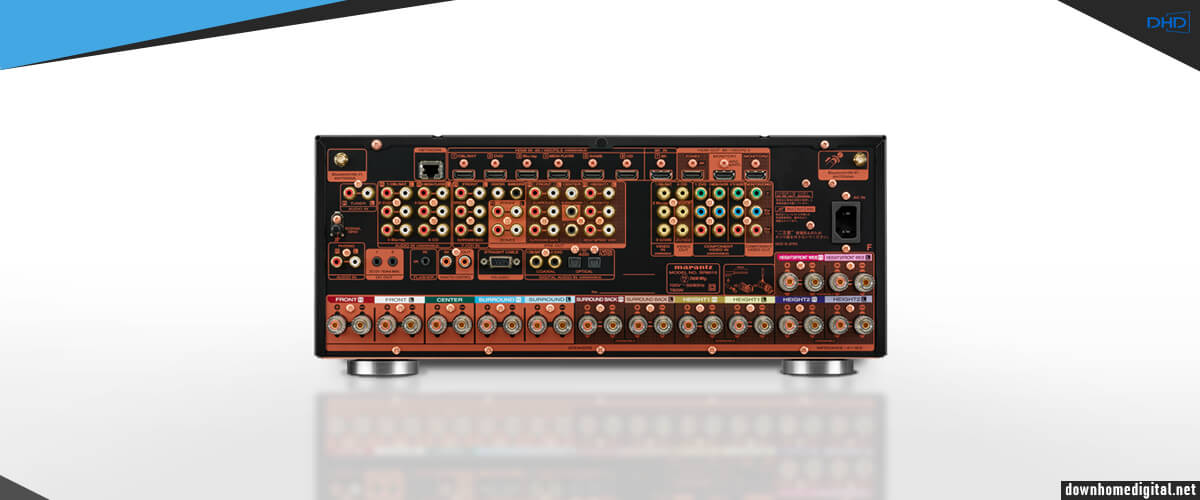
The Marantz SR8015 is a full-fledged 11.2-channel unit that can be expanded to a 13-channel system (with an optional amplifier). It offers a total power output of 140W per channel, making it capable of delivering powerful, immersive audio. Given this number of channels, the device provides flexibility in designing a home entertainment system and also guarantees great sound with an immersive effect.
The Marantz SR8015 has great connectivity, including 8 HDMI inputs and 3 HDMI outputs. But it lags behind the AVR-X4800H in this area, as only 1 input is version 2.1 and supports 8K video. The tribute to the year of release is 2020. I don’t consider this to be the kind of disadvantage that can significantly affect your choice. Nevertheless, it is worth keeping in mind that you can only use one source. There are component video inputs, coaxial and optical digital audio inputs, and a phono input for turntables. The unit also has Wi-Fi and Apple AirPlay 2 compatibility. I used them to stream audio from my iPad to the receiver. Additionally, the receiver supports HEOS multiroom audio.
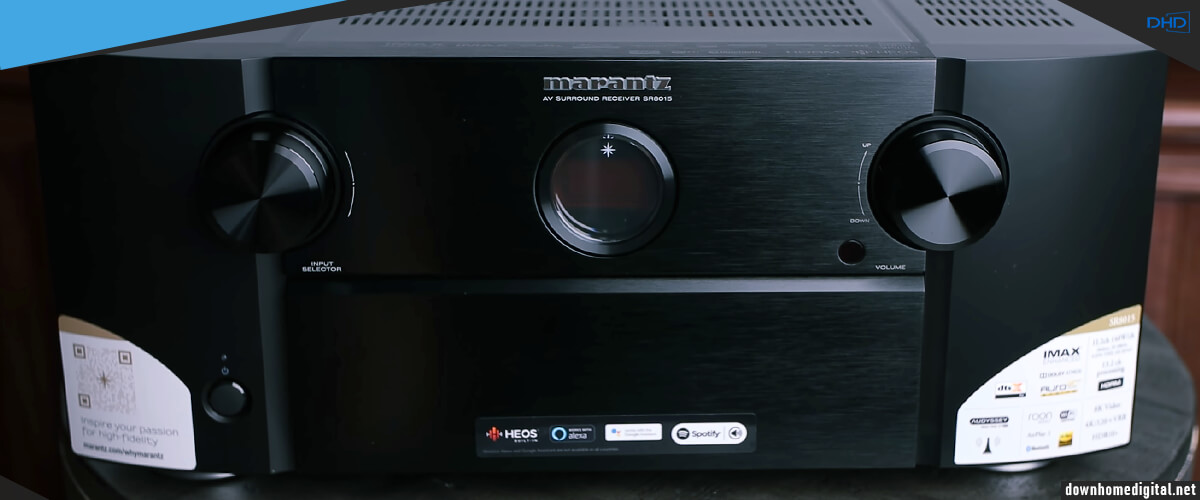
The unit’s audio features include Dolby Atmos, Dolby Atmos Height Virtualization Technology, DTS:X, DTS Virtual, IMAX Enhanced, and Auro-3D. I would also like to mention the DTS:X Pro support. This is a rarity, even among the coolest models.
The Marantz SR8015 didn’t disappoint me with its performance. When I fed it with native 8K content, it ran just fine. Upscaling was another thing. When I made the receiver upscale the native 4K into actual 8K content, the picture is very minor, but hung a few times. It showed somewhat controversial results during my test.
In addition, Marantz has installed the proprietary Marantz Musical Digital Filtering system. It uses advanced algorithms to improve the sound quality of digital audio playback by reducing unwanted noise and signal distortion. Some music tracks have clearly benefited from this. In turn, others have become somewhat artificial in sound. So, music is not its strong point; the SR8015 still sounds a bit paler than the Denon AVR-X4800H (lacking brightness and dynamics in stereo).
If you’ve read this review carefully, it’s clear why the Marantz SR8015 is the best 8K AVR but ranks only 2nd after the Denon AVR-X4800H. For the inattentive (or lazy), I will repeat: Marantz is always about the quality of internal components, about elite (premium, regardless of the category), about the fact that your system will sound the same after a week of use or after 20 years (don’t forget to pick up speakers of the same quality level). The brand utilizes internal components and technology that no other brand can outdo. Including the excellent, my adored Denon, which is more often than not ranked #1 in price/quality ratio. With the Marantz SR8015, you have to pay more for quality.
This model was released in 2020 and can only offer 1 HDMI port with 8K video resolution (upscaling is a bit limp, too). And the SR8015’s stereo lacks Denon AVR-X4800H speakers (though trust me, most of you won’t notice the nuances; everything works fine). But it’s like a vintage box: no chips or the latest technology, but “natural wood and handmade”. It’s up to you!
| Power |
|
| HDMI features |
|
| Video features |
|
| Network |
|
| Surround sound processing |
|
Pros
- Current Feedback Topology and HDAM (Hyper Dynamic Amplifier Module) make the sound unrivaled, and the receiver will sound equally good even after many years.
- The heavy weight of 38.4 pounds (vs. 29.1 for the Denon AVR-X4800H) speaks to using top-of-the-line components.
- A full 11-channel premium amplifier with expandability to 13 channels.
- Marantz Musical Digital Filtering allows for significant noise reduction.
Cons
- Only 1 HDMI input supports 8K video (unlike Denon AVR-X4800H).
- The 8K upscaling gives minor minor minor delays, but the picture quality is good.
- SR8015 lacks the brightness of the Denon AVR-X4800H in stereo.
Denon AVR-S670H – budget
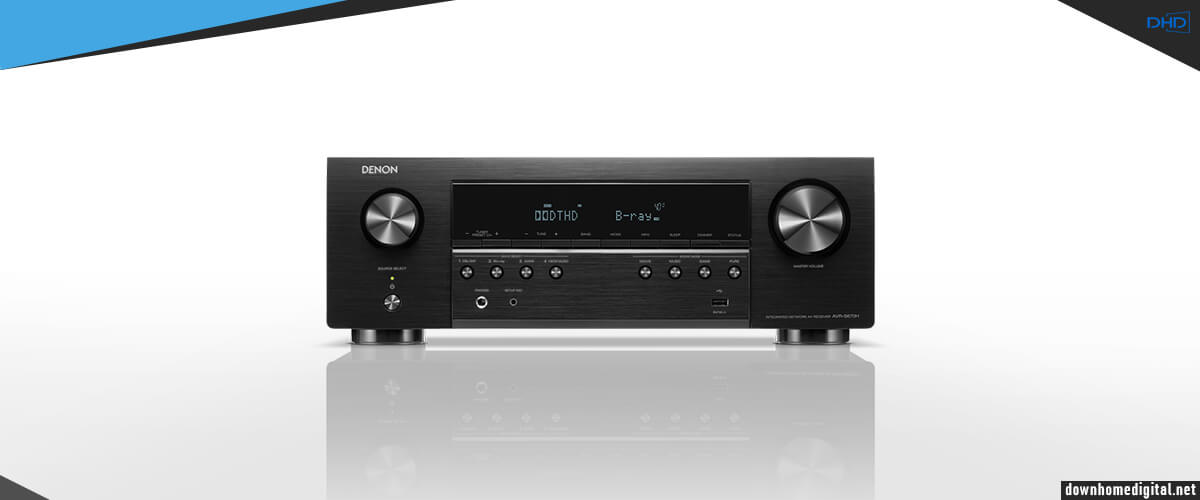
The Denon AVR-S670H is a budget-friendly AV receiver that offers a range of features and capabilities, some of which can even be found in more advanced models. It is a several steps down from the Denon AVR-X4800H but still packs a punch with its technical data and functions. In this review, I will analyze in detail the features of the Denon AVR-S670H and compare the unit with the X4800H, as they are similar in some respects. I will also highlight what makes this receiver a great choice for budget-conscious consumers.
Always look at the receiver’s weight; it speaks about the quality of the components used inside the unit. The AVR-S670H weighs only 17.2 pounds, and compared to the 29.1 pounds of the X4800H, it may seem light. But since we’re talking about a 5-channel device – it’s quite the heavyweight in its segment. The external controls are not hidden under the cover and will require care on your part. But I like pushing the buttons and twisting the controls; they have great feedback and sensitivity. This is a good quality considering its low cost and compared to other budget devices (none on my list). All in all, it’s simple but pretty reliable for the pennies you’ll pay for it.
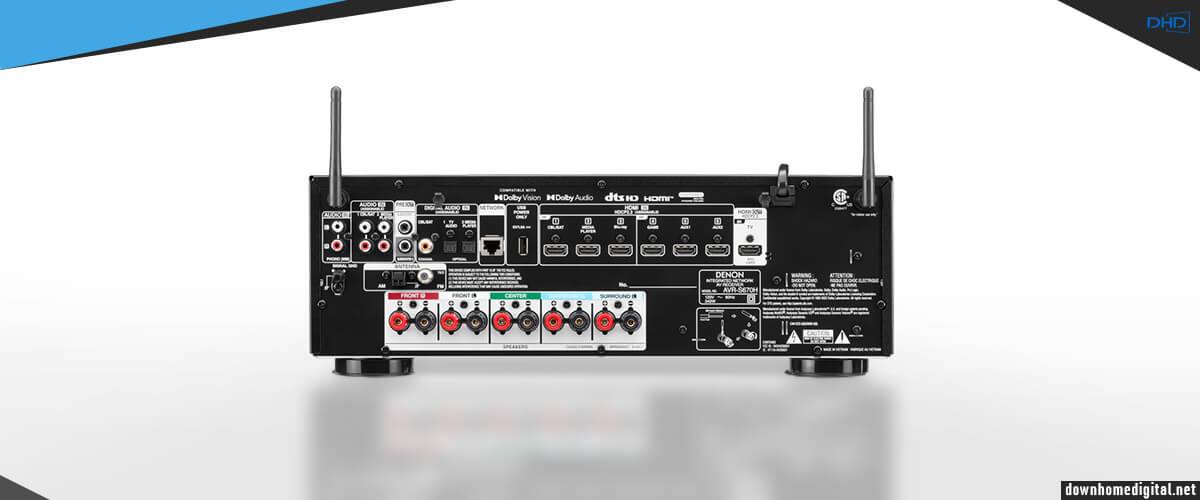
The Denon AVR-S670H only supports 5.2 channels with a maximum output power of 75 watts (8 ohms, 20 Hz – 20 kHz, 0.08%, 2ch), and that’s the smallest power rating.This is a normal indicator for such a receiver, especially since we are not discussing support for Dolby Atmos, DTS:X, or Auro-3D. And the THD indicator loses to other receivers in my review. But if you put a home theater in a small room (150-200 square feet), you’ll get great, crisp, balanced sound in every corner with standard DTS HD Master and Dolby TrueHD formats. It’s decent surround sound, as my test results showed (remember, I’m using equipment, so I choose models that are optimal representatives of their category regardless of rank).
The Denon AVR-S670H is a 5.2-channel unit but has a wide range of connectivity options for its class: 6 HDMI inputs, 3 of which are version 2.1, 1 output (eARC), 2 composite video inputs and outputs, 2 digital optical and coaxial inputs and a USB port. I’d like to point out that this is a wide range of connectivity, as good as the Denon AVR-S970H and Marantz Cinema 60 7-channel chart-topping receivers. The device also features Bluetooth, Wi-Fi, and AirPlay 2. In addition, the receiver supports the Zone 2 function.
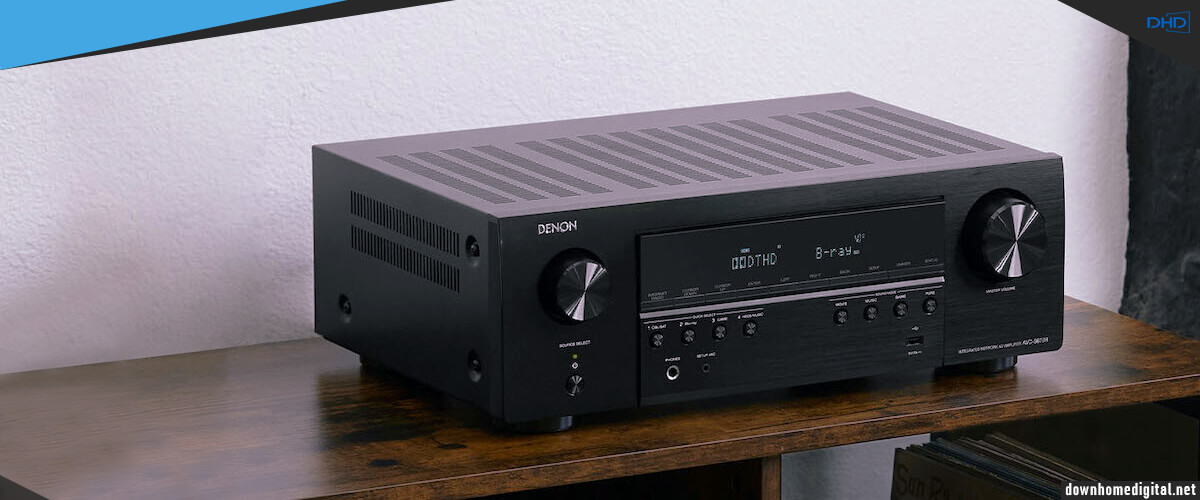
Since, despite its price, it can handle 8K content at 60Hz (a 2023 model, after all), it also includes upscaling technologies to improve 4K content to 8K. But whatever I used as a source, there were bugs, sometimes minor, and sometimes I just wouldn’t recommend using this feature (there were freezes, audio track out-of-sync, and pixelation). At the same time, look at the AVR-S670H as the most budget-friendly, making it a more attractive option for frugal buyers, and forgive its shortcomings. These are compromises that can’t be avoided when you’re saving money.
I also began testing the Denon AVR-S670H with movies. It doesn’t provide as much power as the mighty Denon AVR-X4800H. But it also could be more precise with details. However, I enjoyed the way it handled dialogues and sound effects, especially when that two blended in action moments. The receiver also plays music pretty well. Cranking the volume up to the maximum is not a great idea — even at half the volume, the receiver sounds very powerful and clear, regardless of the music genre.
So, the budget representative of the topic under consideration in this review is Denon AVR-S670H. And it rightfully takes its place, as it is significantly superior to other budget models. But in comparison with those presented in this rating, of course, it is difficult not to notice the compromises you will have to make when buying an inexpensive AVR. Still, you get decent surround sound that will definitely be better than your TV and will keep you happy for years. But I would consider upgrading if you plan to expand your system over time.
The AVR-S670H is significantly inferior to the Denon AVR-X4800H (less power, fewer channels, fewer HDMI ports with 8K support). Still, Denon’s advanced features and technologies (just don’t count on upscaling too much) set it apart from other budget receivers. It’s fully capable of meeting your movie, music, or gaming needs if you’re unassuming and know exactly what you’re going for.
| Power |
|
| HDMI features |
|
| Video features |
|
| Network |
|
| Surround sound processing |
|
Pros
- It is not inferior to other receivers of the rating in 8K support (3 of 6 ports have version 2.1.).
- The number of HDMI ports is the same as in the 7-channel receivers of this chart (Denon AVR-S970H and Marantz Cinema 60).
Cons
- The lowest power rating (75W).
- The construction quality corresponds to the budget segment but loses to those mentioned in the rating.
- It sounds decent only in a small 150-200 square feet room.
- The only receiver in the rating without Dolby Atmos and DTS:X support.
- 8K upscaling works erratically, depending on the source, but always with some errors.
Denon AVR-S970H – under $1000
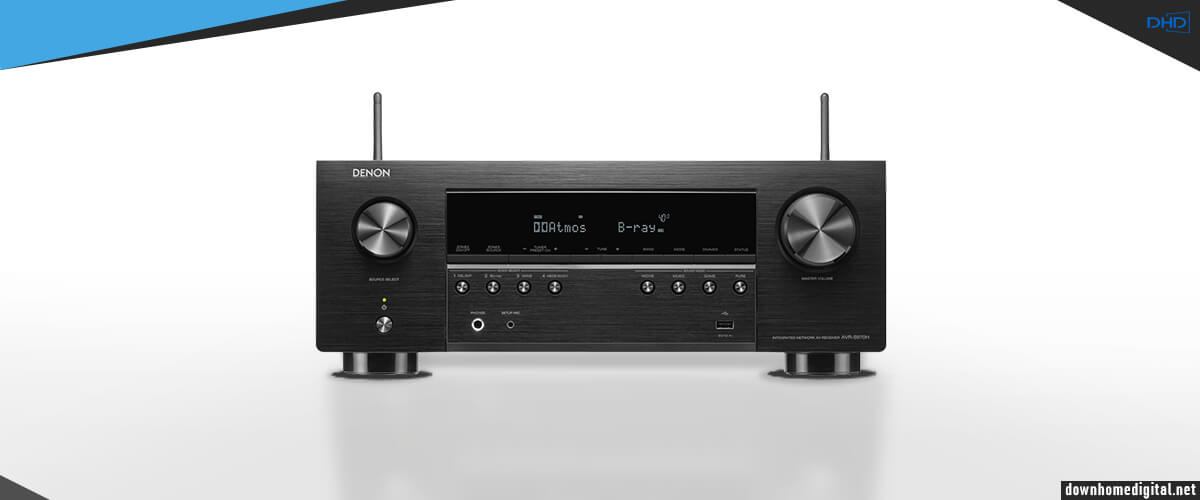
Yes, you read that right. It is the 3rd Denon model in my review. I’m a big fan of this company, and they do have some really cool 8K devices, and that’s why the S970H is on my list. Despite not having the highest price, the AVR-S970H is positioned by Denon as a high-performance AV receiver. It is designed for small to medium-sized rooms where it can drive up to 7 channel audio systems. Denon filled it with cutting-edge features and advanced connectivity options, trying to make it a perfect choice for casual and experienced home theater enthusiasts with budgets under $1000. So, let’s see if the AVR-S970H fulfills its purpose.
The Denon AVR-S970H follows a classic, understated design typical of the brand. It features a black metal casing and a simple, uncluttered front panel with a few buttons and control surfaces. On the front panel, the AVR-S970H has a small OLED display that provides information about the input source, volume, and other settings. As usual, most connectors are located on the back side of the receiver. You will easily notice that they are like twins similar to the AVR-S670H.
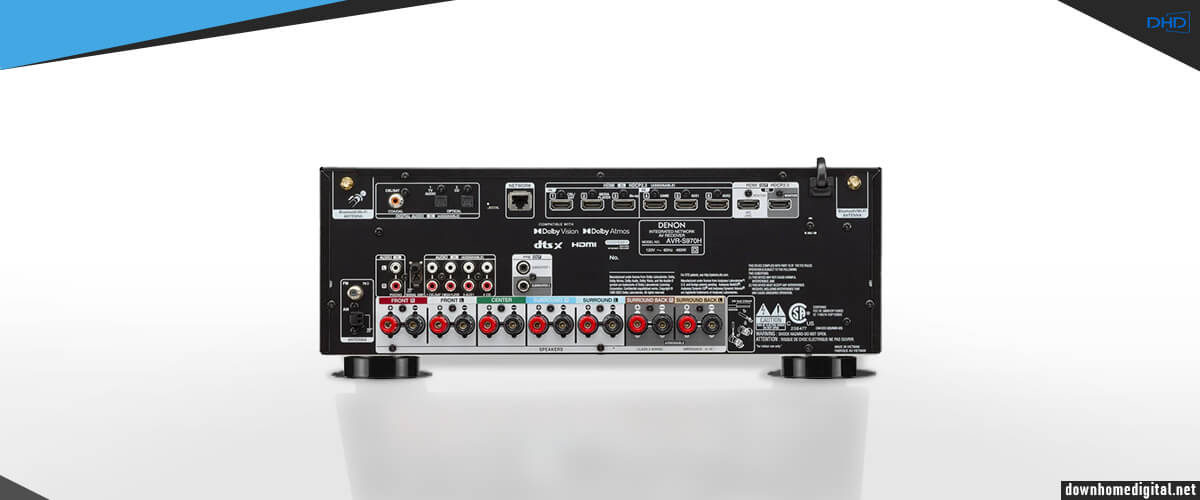
This model boasts several impressive technical specifications, including support for up to 7.2 channel audio with 90 W (8 ohm, 20 Hz – 20 kHz, 0.08%, 2ch). It is more than enough to fill a medium-sized room with sound (up to 300 square feets). If we talk about connectivity options, the Denon AVR-S970H has 6 HDMI inputs, 3 of which are version 2.1, and 2 outputs, 3 composite and 2 component video inputs with single composite and component output, 4 analog audio inputs and 1 coaxial digital output, plug a headphone jack. The primary HDMI output supports eARC. Dedicated 8K input supports 8K UHD/60 Hz and 4K UHD/120 Hz pass-through and upscaling. All HDMI inputs support 4:4:4 Pure Color, Dolby Vision, HDR10/10+, HLG subsampling, and BT.2020 pass-through for enhanced color, clarity, and contrast. In addition, 8K upscaling and HDCP 2.3 compatibility are available on all HDMI inputs.
It also supports current streaming services and has Bluetooth, Wi-Fi, and Ethernet connectivity. Above this, the unit has a very simple menu, making it easy to operate the receiver even for the least experienced users. In fact, I find no differences here in the number of features or signal quality relative to the AVR-S670H, other than the obvious number of channels and more power.
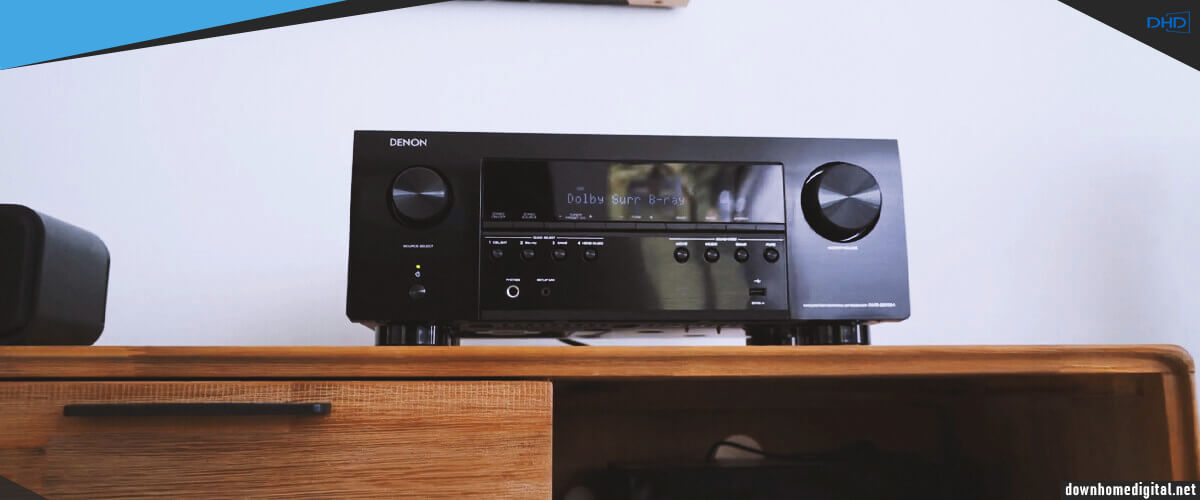
The device works correctly with a wide range of acoustics and supports the latest surround sound formats: Dolby Atmos, DTS: X, DTS Virtual:X, and Dolby Atmos Height Virtualization. And now, let’s move on to my personal impressions of the sound.
The receiver didn’t let Denon down during my tests, as it worked very well, especially when keeping its price in mind. It surprised me how well it can handle the separation of dialogue, sound effects, and background music. The AVR-S970H showed exceptional control over the dynamic range and impactful movie sound. Typically for the receivers, it performed less prominent in music. Still, the unit gave crisp and clear sound with hard rock and heavy metal and stable heights and lows with ballads and classical music. But it’s worth noting that its power is the smallest among the 7-channel receivers in my ranking.
The first 7-channel receiver of my selection is not the brightest representative among other similar models of the rating (Marantz Cinema 60 and Yamaha RX-A4A), being inferior to them in power. But it costs less. But it wins over the 5-channel AVR-S670, offering more channels and Dolby Atmos. Essentially, it remains a pretty budget option, so if I were you, I’d consider it and probably pay an extra couple hundred for more features.
The Denon AVR-S970 handles 8K content just fine, and it has 3 HDMI ports for sources of this format. Wireless technology does not let it down; signal broadcasting showed good results in different variations. I would call it a “golden mean” between the chart’s most budget and other 7-channel models. In my experience, quality workhorses are worth many buzzwords to more “advanced” competitors. Add to this the warm, bright, dynamic sound that the brand’s products invariably possess, and you won’t regret your choice after spending less than $1000.
| Power |
|
| HDMI features |
|
| Video features |
|
| Network |
|
| Surround sound processing |
|
Pros
- Essentially, for just a couple hundred bucks on top of that, you get a system with more features than the AVR-S670, including Dolby Atmos.
- It has a lower price tag than competitors Marantz Cinema 60 and Yamaha RX-A4A, second only to the quality of internal components (which you won’t notice unless you know a lot about sound or have meters).
Cons
- Except for supporting more advanced surround sound formats, the receiver completely repeats the compromises (I can’t call it a flaw) of AVR-S670, lagging behind the more advanced leaders of the rating.
- It has the lowest power among 7-channel receivers of this review.
Marantz Cinema 60
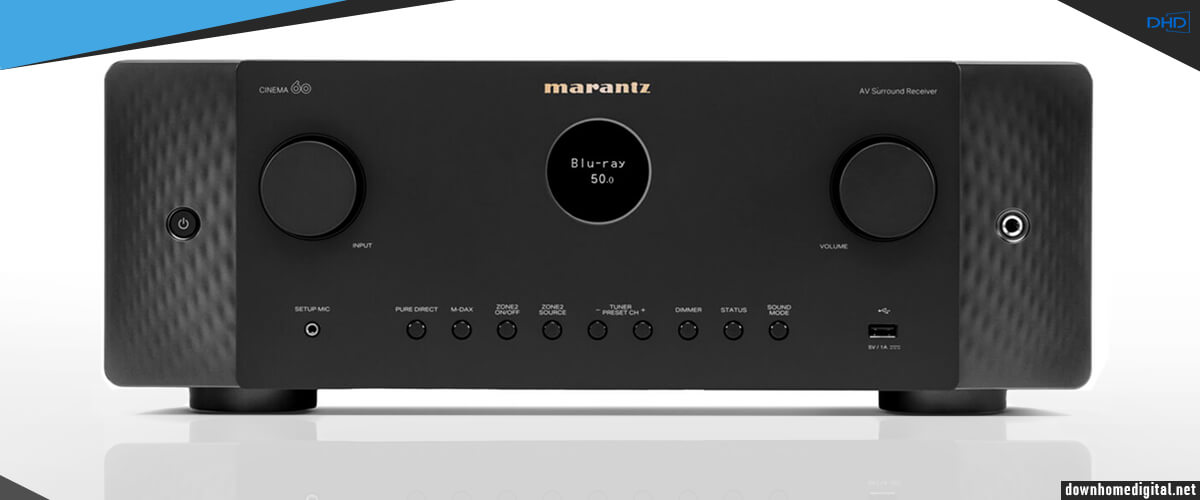
“The CINEMA series is a combination of three pillars based on the traditional Marantz values of exceptionally high efficiency, impeccable build quality, and elegant appearance,” says Joel Sietsema, president of the company. Well, let’s see if that’s true.
Marantz’s build is never in doubt; I have already told you why you always pay more in the case of this brand. But the design and controls make me resent it. Sure, the Marantz Cinema 60 was released in 2022 and is a modern device so you can rely on the controls. But I’m all for features working, ring they are stated. Yes, the AVR is very nice, but that round screen… well, why is it there? You can’t see anything on it. The controls are all push-button, and the buttons are recessed so much that I can hardly feel them under my fingers, pawing the whole front panel. Plus, they’re limited. The backlit remote brought me back to life, though, and I focused on customizing and testing. But it’s kind of horrible (for me).
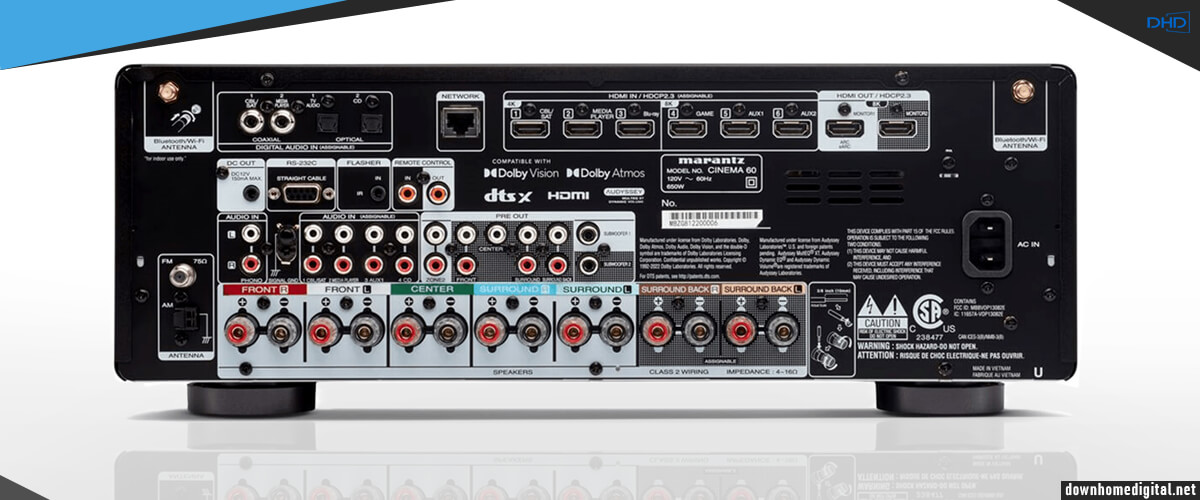
The Cinema 60 is a 7.2-channel unit. It delivers 100 W (8 ohms, 20 Hz – 20 kHz, 0.08%, 2ch), which in practice doesn’t make it much different from the Denon AVR-S970. But the Current Feedback Topology and HDAM (Hyper Dynamic Amplifier Module) used, which I mentioned in my review of the Marantz SR8015, are the invisible bonuses for which you pay double the price.
This model has 6 in, 2 out HDMI ports, half of which are 2.0, the other 3 are 2.1 version (for 8K resolution), 2 coaxial optical inputs, 4 analog stereo RCA audio, single phono, front headphones, and a sole USB port, 7 speakers outputs, Ethernet. The receiver also supports wireless connectivity, including Wi-Fi, AirPlay, Bluetooth, and AM/FM. In addition, Marantz Cinema 60 has a Zone 2 feature and can work with HEOS-compatible speakers.
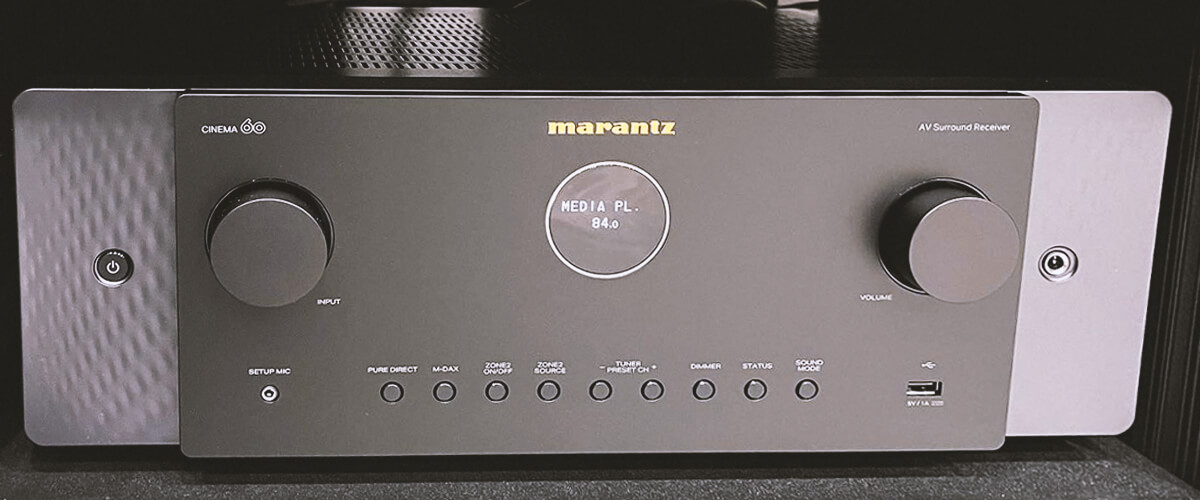
As a high-end model, it supports high-definition audio as well as most of today’s surround sound formats, including Dolby Atmos and DTS:X. DTS Virtual:X and Dolby Atmos Height Virtualization are also available.
I didn’t find any major flaws in the sound when I tested the Marantz Cinema 60 in movies. The receiver utilizes its support of Dolby Atmos and DTS:X to the maximum. It offered a dynamic sound stage, crisp dialogue reproduction, and tight bass response. Altogether, a very solid result. Despite this, I also had to adjust the sound manually to make it juicier. Yet, this can is my personal preference. What’s interesting is that its tight bass capability also showed itself well in music giving goosebumps.
If you still don’t get it, that’s okay. I’ll say it again. With the same initial data, Marantz Cinema 60 and Denon AVR-S970 (plus or minus similar power with the same THD, number of channels, sound warm picture, dispersion and level of sound processing, number and functionality of HDMI-ports, built-in streaming services, HEOS multiroom), Marantz will always cost more. Why twice as much? Ask the brand reps. But if they asked me, I don’t see much point in paying more.
Nevertheless, you can’t say that I deny the elite and quality of the Marantz Cinema 60. This receiver is great, and everything it does is superb. So, if you have the finances, why not show it off? However, for the same money, you can buy a Denon AVR-X4800H with 11 channels of amplification and the ability to expand the system to 13 channels. Too honest? Well, that’s me.
| Power |
|
| HDMI features |
|
| Video features |
|
| Network |
|
| Surround sound processing |
|
Pros
- The backlit remote control solves the problems of manual operation on the panel.
- As usual, you pay double the price for advanced technology and components that will last years.
Cons
- The front panel push-button controls and small LCD leave much to be desired. Uncomfortable.
- At a higher price (twice the price), it marginally outperforms the obvious features of the Denon AVR-S970H.
Yamaha RX-A4A
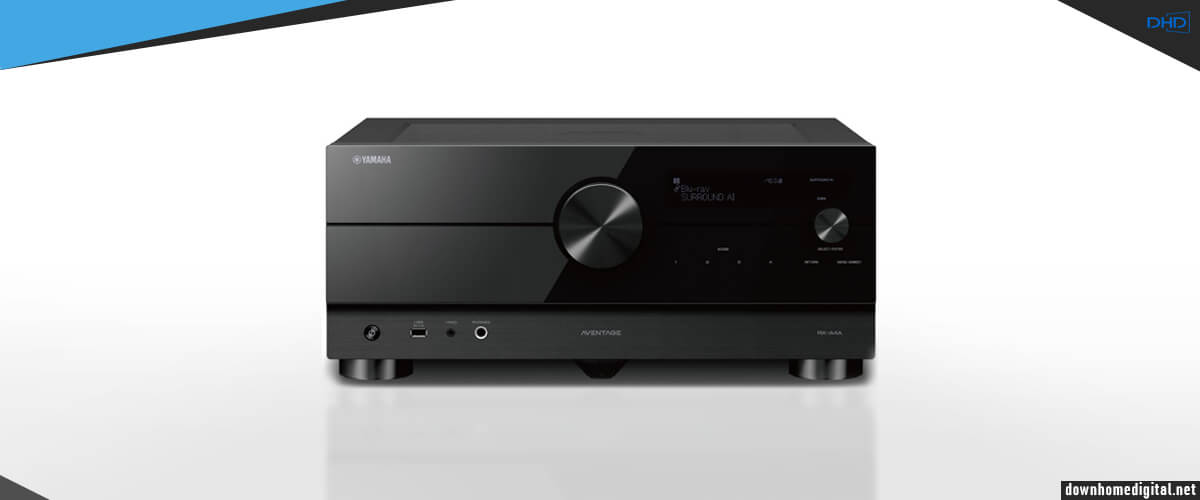
When in 2021 Yamaha first showed the RX-A4A, it was clear that this unit would aim to score the highest price. It is an impressive 7.2-channel AV receiver. Typically for this review, it is rated as one of the coolest 8K AV receivers available on the market due to its s 8K capabilities, upscaling technology, and modern audio and video technology support. In this part of the review, I will take a closer look at the technical data and functions of the Yamaha RX-A4A as well as some aspects. I have not previously compared the Marantz Cinema 60 with the RX-A4A, but these two devices are the most dangerous rivals. Accordingly, the cost of the Yamaha is closer to the Marantz but still slightly lower.
Why brands compete on whose design is more pointless is a mystery to me. But compared to the Cinema 60, it offers an even more awkward LCD. It’s located under the glossy panel and is not even visible in the photo on the manufacturer’s website. I think it looks even more dismal in person. Yes, of course, it is very beautiful. The receiver will decorate your interior, no doubt. But I always handle Yamaha’s Aventage AVRs with gloves on. Do you need that? Unless you have a cleaning lady in your house that you treat inhumanely. Dust is just attracted to this unit, not to mention fingerprints. And the controls are touch screens! It’s a mockery, for God’s sake. But to balance my subjective opinion, I would like to add that there is a fifth leg for anti-resonance. And, of course, Yamaha technologies are ahead of many brands, so we are talking about a premium receiver, even when we are talking about 7 channels of amplification.
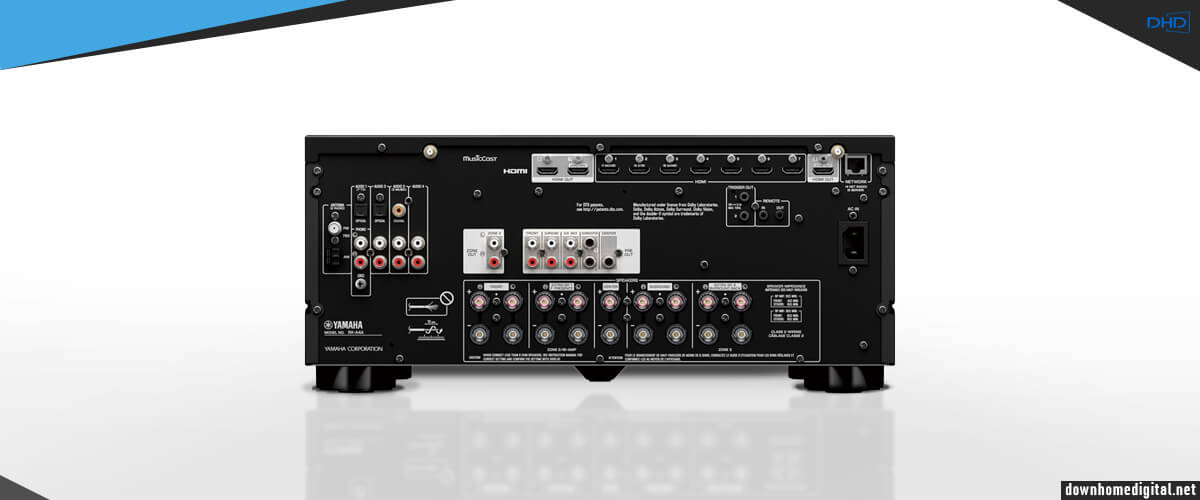
Just like Yamaha promised, the RX-A4A boasts 8K resolution, providing ultra-clear images with exceptional detail and vibrant colors. Like the others from the list, the RX-A4A supports HDMI 2.1, enabling it to stream 8K content at 60Hz, delivering smooth and fluid motion on the screen. But importantly, it’s the only 7-channel receiver with all inputs (7, and that’s more than the other 7-channel receivers in my selection) that support this resolution. In addition, the upscaling technology of the Yamaha RX-A4A can transform lower-resolution content into 8K, providing a more engaging viewing experience.
The receivers are also equal with their set of Dolby Atmos and DTS:X immersive surround sound technologies, and both units work with older HDR10 and HLG, delivering video with high dynamic range.
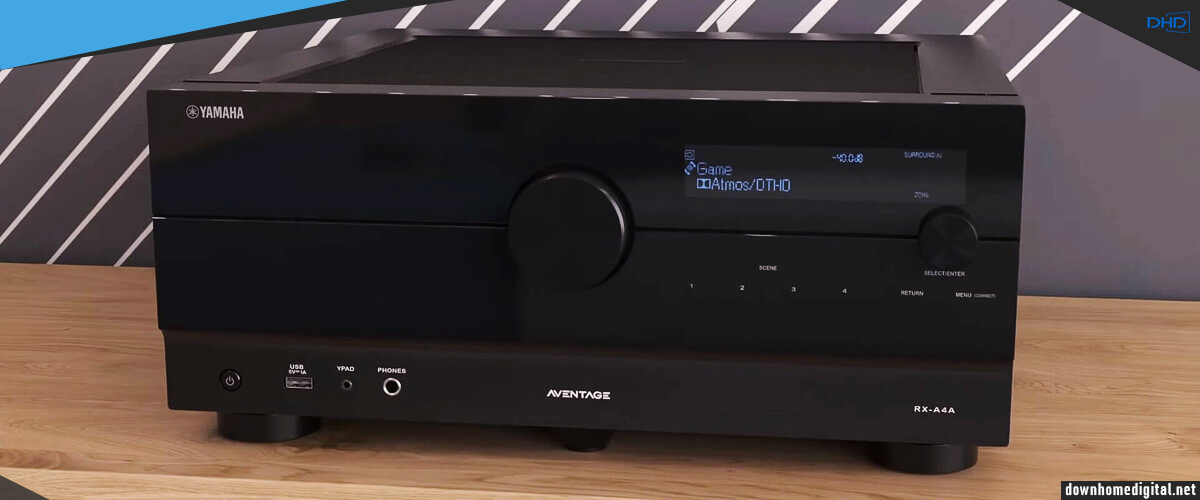
It’s really pointless just to list the features of the RX-A4A, as you won’t find any meaningful differences. However, there are some unique technologies and components that are worth mentioning. Let me start with YPAO R.S.C. with 3D, multipoint measurement, precision EQ, and low-frequency mode. I like it less than Audyssey MultEQ XT (or Dynamic EQ). Although it’s a more advanced version of Yamaha’s standard room correction system, it still does a worse job of tuning if you have a specific interior (columns, beams, large furniture). Still, it did well in a “sterile” studio (you bet, for that kind of money, and it was quite worthless). For movies, and even better for concert recordings or sports broadcasts, I highly recommend the CINEMA DSP HD3 technology. It’s an incredibly interesting solution with the acoustics that the brand offers us. If we add a virtual helmet, I would have an 85% chance of feeling in the center of the action. But still, 7 channels don’t give such a vast sound picture as receivers with 11 or 13 channels (which is natural).
In stereo, I could appreciate the work of ESS SABRE ES9007S Premier Audio DAC. And even though I’m not a fan of Yamaha’s cold crystalline sound, my instruments captured a high-end picture. At 110 W (8 ohms, 20Hz-20kHz, 0.06% THD, 2ch), I could literally see the waves moving (on the instruments, of course) and the points they reach. By the way, this is the highest power among the 7-channel devices of my selection and lower THD. Whether you will notice the difference is not a fact. But you will definitely not remain indifferent.
Yamaha RX-A4A can’t help but attract attention because of its unusually beautiful design (which easily leaves all dust and fingerprints) and superbly balanced sound. This receiver has the largest number of HDMI ports, all of which support 8K video. You also get the HD3’s unique CINEMA DSP for acoustics and AI technology for real-time sound analysis. It’s also the most powerful among the 7-channel receivers in my rankings, and that matters. All of this is something worth paying higher prices for than the Denon AVR-S970. But only if you’re not embarrassed by the hand-tuning (the YPAO is inferior to the Audyssey from Denon and Marantz) and the cold, metallic tinge to the sound inherent in the Yamaha. But those of you who love this unique feature are unlikely to want to listen to anything else in the future.
| Power |
|
| HDMI features |
|
| Video features |
|
| Network |
|
| Surround sound processing |
|
Pros
- The 7-channel receiver has the highest number of HDMI ports (7/3 vs. 6/2) in the rating.
- All HDMI ports support 8K video.
- The HD3’s unique CINEMA DSP technology creates the natural acoustics of a concert hall or stadium but is also good for movies.
- The most powerful among the 7-channel receivers in the ranking.
- Surround:AI technology for real-time sound analysis – a unique Yamaha technology.
Cons
- The glossy surface attracts dust, and you’ll easily leave fingerprints on the touch panel.
- The YPAO calibration system is inferior to Audyssey by Denon and Marantz.
- The receiver’s cold, metallic sound will not suit all users.
FAQ
Is 8K worth the money?
Benefits of 8K technology include a more quality video. The larger the resolution, the more details every inch of the screen contains. However, 8K content is still limited, and very few 8K TVs and displays are available in the market, being quite expensive. So, is it worth spending a significant amount of money on such a purchase?
Considering the lack of native 8K content, many rely on upscaling, which is not native 8K. So, if you’re on a budget and there’s limited 8K content available in your area, it might be better to wait until more of it becomes available, and prices drop. But on the other hand, the answer is obvious, if you are not a fan of innovations and new technologies, have the necessary sum, and are not ready to wait!
Can the human eye tell the difference between 4K and 8K?
The ability of the human eye to distinguish between 4K and 8K resolution can depend on several factors, such as screen size and viewing distance. At typical viewing distances, the human eye may not be able to see a significant difference between 4K and 8K resolution. However, as screen sizes get larger and viewing distances get shorter, the difference between 4K and 8K resolution may become more noticeable.
Additionally, the human eye’s perception of resolution is not just limited to the number of pixels on the screen. Other factors, such as image quality, color accuracy, and brightness, can also play a role in the overall perceived quality of the image. Under certain circumstances, 8K technology does offer several benefits, including a more natural viewing experience, making it a desirable option for connoisseurs.
Is it worth buying an 8K TV?
Currently, 8K content is scarce, and only a limited number of broadcasts are available in this resolution. Most of what is available to viewers are still 4K or lower. Consequently, the full advantage of 8K technology has yet to be uncovered.
However, even with the limited content, 8K TVs boast numerous benefits and modern features. Hence, if you’re a technology aficionado who craves the ultimate viewing experience, investing in an 8K TV might be worth it.
What 8K content is available now?
You can already find 8K content on YouTube, and we are talking more than just about videos about nature. A growing number of channels there switches to 8K. There are currently a few native 8K videos available on streaming platforms like Netflix, Disney+, Apple TV, or Amazon Prime Video. On the other hand, in gaming, you can select any resolution supported by your hardware. But that’s where the trick lies. To play in 8K, you need top-of-line hardware—even the RTX 4090 struggles in the same games in 8K. So while gaming is technically available and totally under your control, you still may find it pretty problematic.
So, you can expect the number of 8K content of all types to increase with time. But, at the same time, the prices for the 8k-capable equipment would definitely decrease. Therefore, the chances are high that, pretty soon, 8K content can literally “blow up” the market, and there will be a lot of it. Thus, those who have devices to play it will have an advantage. Also, you can view the best av receiver 2025 to keep up with the times.

